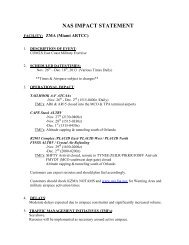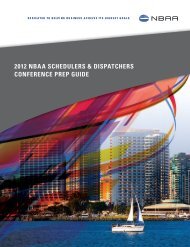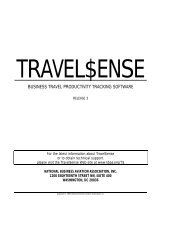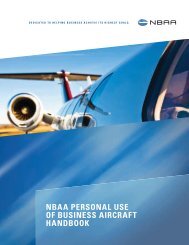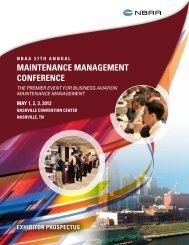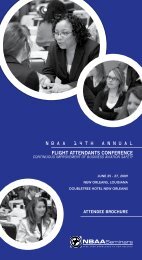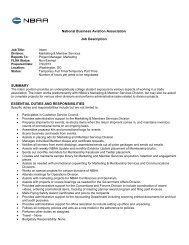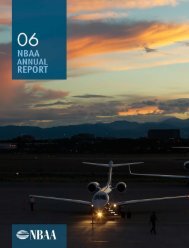Overcoming Current Operations Challenges for Part 91 and ... - NBAA
Overcoming Current Operations Challenges for Part 91 and ... - NBAA
Overcoming Current Operations Challenges for Part 91 and ... - NBAA
- No tags were found...
You also want an ePaper? Increase the reach of your titles
YUMPU automatically turns print PDFs into web optimized ePapers that Google loves.
<strong>NBAA</strong> Domestic <strong>Operations</strong> Committee:<strong>Overcoming</strong> <strong>Current</strong> <strong>Operations</strong><strong>Challenges</strong> <strong>for</strong> <strong>Part</strong> <strong>91</strong> <strong>and</strong> <strong>Part</strong> 135<strong>NBAA</strong> Annual Meeting & ConventionAtlanta, GeorgiaOctober 19, 20102
OverviewIntroduction – David Norton, Chair of the DOCShuttle Working Group Update (Will Das)SMS Implementation (Lucille Fisher)<strong>Part</strong> <strong>91</strong> Operational Control (Aaron Goerlich)<strong>Current</strong> <strong>Part</strong> 135 Issues (Ashley Smith)LOAs <strong>and</strong> OpSpec Issues (David Norton)Questions & Close3
Domestic Ops: Shuttle Work GroupWill DasJohnson Controls49541Ecorse RoadBelleville, MI 48111Office: (734) 358-0106Email : Willem.Das@jci.com4
Training/Checking <strong>Part</strong> 142 SchoolsFAR 61.58 Progressive check under <strong>Part</strong> 125 Common practice <strong>for</strong> checks under 61.58 AFS 820 approval For 125 operators.5
Training/Checking <strong>Part</strong> 142 Schools125.2<strong>91</strong> Aircraft substitution LODA Operators with both <strong>91</strong> <strong>and</strong> 125 Ops Ease training yearly training/Checking burden Requested through local FSDO FSDO may request AFS 820 approval6
125.211 (b) 125.269 (c) Flight Attendant Requirements. applicability local FSDO interpretation Inconsistencies7
Beginning a shuttle operationAvailable <strong>NBAA</strong> resources through the DOC Shuttle work group Mature shuttle operations <strong>91</strong> vs.125 Analyzing route structure Presentation to management Match aircraft to mission8
SMS ImplementationLucille FisherQUALITY RESOURCES, LLC355 Richmond RoadRichmond Heights, OH 44143Office (216) 797-1710lfisher@qualityresources.biz9
Safety Management SystemDefinitionThe systematic <strong>and</strong> comprehensive process <strong>for</strong>the proactive management of safety-risks thatintegrates the management of operations <strong>and</strong>technical systems with financial <strong>and</strong> humanresource management.10
ICAO Annex 6 <strong>Part</strong> IIDriving <strong>for</strong>ceChapter 3.3 General3.3.2 Safety management system3.3.2.1 An operator shall establish <strong>and</strong> maintain a safetymanagement system that is appropriate to the size <strong>and</strong>complexity of the operation.11
Annex 6 <strong>Part</strong> IIChapter 3.33.3.2.2 Recommendation. – The safety management systemshould as minimum includea) a process to identify actual <strong>and</strong> potential safety hazards <strong>and</strong>assess the associated risks.b) a process to develop <strong>and</strong> implement remedial action necessaryto maintain an acceptable level of safety; <strong>and</strong>c) provision <strong>for</strong> continuous monitoring <strong>and</strong> regular assessment ofthe appropriateness <strong>and</strong> effectiveness of safety managementactivities.12
Annex 6 <strong>Part</strong> IIChapter 3.3Note – Guidance on safety management systems is contained inthe Safety Management Manual (SMM) (Doc 9859) <strong>and</strong> industrycodes of practice.13
What about the FAAAC 120-92ARecently publishedThis advisory circular (AC) provides a Framework <strong>for</strong> SafetyManagement System (SMS) development by aviation serviceproviders. It contains a uni<strong>for</strong>m set of expectations that align withthe structure <strong>and</strong> <strong>for</strong>mat of the International Civil AviationOrganization (ICAO) Framework; <strong>and</strong> Aviation Safety (AVS)policy in Federal Aviation Administration (FAA) Order VS8000.367, AVS Safety Management System Requirements,Appendix B.14
Implementing Safety Management SystemsYou already do it!Write it downCreate a systematic approach to safety <strong>and</strong> operational issuesConsider the International St<strong>and</strong>ard <strong>for</strong> Business Aviation<strong>Operations</strong> – IS-BAOWhat do you have to do to comply with the ICAO requirements?15
<strong>Part</strong> <strong>91</strong> Operational ControlAaron A. GoerlichGarofalo Goerlich Hainbach PC1200 New Hampshire Ave NWWashington DC 20036-6802Office (202) 776-3974agoerlich@ggh-airlaw.com16
<strong>Part</strong> <strong>91</strong> Operational Control Concern: some <strong>Part</strong> <strong>91</strong> operators do not fully grasp concept ofaircraft operational control (O/C) unaware or unsure which entity FAA considers <strong>and</strong>/or requires to bein O/C Additional Concern: issue especially prevalent when aircraftmanagement is outsourced Goal: clarify appropriate roles <strong>and</strong> responsibilities with respect toO/C17
FAA definitions of operational control <strong>and</strong>operate (FAR 1.1) “Operational control, with respect to a flight, means the exerciseof authority over initiating, conducting or terminating a flight.” “Operate, with respect to aircraft, means use, cause to use orauthorize to use aircraft, <strong>for</strong> the purpose (except as provided in<strong>91</strong>.13 of this chapter) of air navigation including the piloting ofaircraft, with or without the right of legal control (as owner,lessee, or otherwise).” Broadly-worded definitions, by design Authority – <strong>and</strong> the exercise thereof – is key19
Three fundamental questions in determining whohas O/C Who makes decision to assign flight crewmembers <strong>and</strong> aircraft<strong>for</strong> a flight? Who makes decision to initiate, conduct <strong>and</strong> terminate the flight? For whom do the pilots work as direct employees or, alternatively,as agents? Common thread: exercise of authority20
Answer to all three questions should be thesame… …<strong>and</strong> that is (or should be) the entity with operational control Compare <strong>Part</strong> 135 requirement: system of “complete, effective<strong>and</strong> sustainable O/C” Why not take same approach to <strong>Part</strong> <strong>91</strong> operations?21
Re: Who makes decision to assign flightcrewmembers <strong>and</strong> aircraft <strong>for</strong> a flight?<strong>NBAA</strong> survey results:For aircraft on a<strong>Part</strong> 135certificate, whoassigns theflightcrew/aircraft to theflight?Certificateholder makesdecisionwithout inputfrom aircraftownerAircraftownerrecommends,certificateholder makesfinal decisionAircraftowner makesfinal decisionOtherFlightcrew 67.6% 17.6% 11.8% 2.9%Aircraft 48.6% 31.4% 8.6% 11.4%22
Re: Who makes decision to initiate, conduct <strong>and</strong>terminate the flight?<strong>NBAA</strong> survey results:Who exercisesauthorityto initiateeachflight?Aircraftowner<strong>Part</strong> 135operator/managementcompany<strong>Part</strong> <strong>91</strong>-onlymanagementcompanyOther<strong>Part</strong> <strong>91</strong> flights 67.0% 17.0% 6.8% 9.1%<strong>Part</strong> 135 flights 8.8% 82.4% 2.9% 5.9%23
Re: For whom do the pilots work as directemployees or, alternatively, as agents?<strong>NBAA</strong> survey results:Who pays thewages orsalary offlight crewmembersused <strong>for</strong> <strong>Part</strong><strong>91</strong>/<strong>Part</strong> 135flights?Aircraftowner<strong>Part</strong> 135operator/managementcompany<strong>Part</strong> <strong>91</strong>-onlymanagementcompanyAircraftowner <strong>and</strong>managementcompanyeach paypartOther<strong>Part</strong> <strong>91</strong> 60.9% 21.8% 8.0% 4.6% 4.6%<strong>Part</strong> 135 13.5% 59.5% 5.4% 13.5% 8.1%24
Other survey results of special interest:Are passengers briefed on who is in operationalcontrol of each flight?YesNo<strong>Part</strong> <strong>91</strong> 21.6% 78.4%<strong>Part</strong> 135 60.0% 40.0%Does youragreement withthemanagementcompany/<strong>Part</strong>135 operatordelineate clearlywho is inoperationalcontrol of eachflight?The agreement isclear that the aircraftowner is inoperational controlof <strong>Part</strong> <strong>91</strong> flights <strong>for</strong>the owner <strong>and</strong> thatthe managementcompany/<strong>Part</strong> 135operator is not inoperational controlof such flights. Italso indicates thatthe <strong>Part</strong> 135 operatorwill be in operationalcontrol of its <strong>Part</strong>135 flights.Theagreementindicates thatthemanagementcompany/<strong>Part</strong> 135operator is inoperationalcontrol of allflights.The agreement isclear that theaircraft owner isin operationalcontrol of <strong>Part</strong> <strong>91</strong>flights <strong>for</strong> theowner <strong>and</strong> that themanagementcompany/<strong>Part</strong> 135operator is not inoperationalcontrol of suchflights.Theagreement isunclear ordoes notaddress thesubject ofoperationalcontrol.I don’tknow whattheagreementprovides. 53.8% 23.1% 5.1% 5.1% 5.1% 7.7%Other25
Other O/C considerations <strong>and</strong> pitfalls O/C system described in manuals or otherwise in written <strong>for</strong>m? (highlyrecommended) O/C responsibility not transferable (though functions can be delegatedto qualified personnel) Passengers briefed on O/C? (compare fractional - FAR <strong>91</strong>.1013; seealso <strong>91</strong>.1009 <strong>and</strong> <strong>91</strong>.1011) Transfers of possession of aircraft must be legal <strong>and</strong> effective (cont’dnext slide)26
Other O/C considerations <strong>and</strong> pitfalls (cont’d) Sample lease provision: Lessee shall have complete, effective <strong>and</strong> sustainableoperational control over the Aircraft whenever operated under this Agreement.Lessee's operational control over the Aircraft shall include without limitation thesole authority to make flightcrew assignments, to designate the Aircraft <strong>for</strong> theper<strong>for</strong>mance of any particular flight, <strong>and</strong> to make decisions regarding theinitiation, conduct <strong>and</strong> termination of any particular flight. Lessee shall beaccountable <strong>and</strong> liable <strong>for</strong> the acts <strong>and</strong> omissions of each flightcrew member.Lessor agrees <strong>and</strong> acknowledges that Lessee shall have sole operationalcontrol of the Aircraft <strong>and</strong> Lessor shall take no action that would interfere with ordiminish such operational control by Lessee. Similar provisions in aircraft management agreement? Should be. Also – Where aircraft “migrates” between <strong>Part</strong> <strong>91</strong> <strong>and</strong> <strong>Part</strong> 135 operations,agreement must make clear: <strong>91</strong> operations: Owner has O/C 135 operations:Air Carrier Certificate holder (management company) has O/C27
Flight crewmember issuesDistinction between direct employees (W-2) <strong>and</strong> agents Note - 2006 FAA guidance:“The significance of the words „agent‟ <strong>and</strong> „agents‟ as used in these [135] operationsspecifications is that the certificate holder is the principal <strong>and</strong> that the certificate holderis accountable <strong>and</strong> liable <strong>for</strong> the acts or omissions of each of its agent(s).” Same principle applies <strong>for</strong> <strong>Part</strong> <strong>91</strong> operations - see FAA legal interpretation issued9/10/2007 to self-employed contract pilot flying <strong>Part</strong> <strong>91</strong> flights:“When you fly [aircraft owner <strong>and</strong> owner‟s employees] on [owner‟s] aircraft, if [owner]does not acknowledge that you are [owner‟s] direct employee or agent <strong>for</strong> the flight <strong>and</strong>does not acknowledge that [owner] is liable <strong>for</strong> your actions <strong>and</strong> inactions, then [owner]is not assuming operational control of the flight. Instead, it would appear that [owner]has hired you <strong>for</strong> your aviation expertise to transport [owner] <strong>and</strong> [owner‟s] employeesfrom point to point. As such, you would have operational control of this „compensationor hire‟ flight. As such you would have to be certificated to conduct <strong>Part</strong> 135operations.”Importance of written agency agreements with pilots28
Aircraft Management Outsourced? In particular, <strong>91</strong>/135 “migrations” trigger variety of O/C issues Contents of agreements vital In-house? Be wary of flight department company issue – if FDC, commercialoperations in FAA’s eyes, 135 certificate required29
In sum, it pays to have a structured <strong>Part</strong> <strong>91</strong>operational control system Enhance safety Minimize regulatory risk Minimize unanticipated liability exposure30
<strong>Part</strong> 135 IssuesW. Ashley Smith Jr.President / Director of <strong>Operations</strong>Jet Logistics, Inc.5400 Airport Drive, Suite 1311Charlotte, NC 28208Office: (<strong>91</strong>9) 840.0555Email: ashley@jetlogistics.us31
OSWG Update (Ops Spec Working Group)C052/C053/C074, Basic Straight-in Non-Precision, APV, <strong>and</strong> Category 1Precision Approach <strong>and</strong> L<strong>and</strong>ing Minima-All AirportsHistory: Third Quarter, 2008 FAA decided to combineC052/C053/C074Why: What are the regulatory requirements with regard to recurrenttraining <strong>and</strong> checking requirements <strong>for</strong> pilots using st<strong>and</strong> aloneGPS units?Issue: Initial draft Ops Specs language required pilottraining/checking in each aircraft make/model/GPS combination32
OSWG Update (Ops Spec Working Group)C052/C053/C074, Basic Straight-in Non-Precision, APV, <strong>and</strong> Category 1Precision Approach <strong>and</strong> L<strong>and</strong>ing Minima-All AirportsPotential issues:1. Fleets with multiple GPS units2. Simulators with different <strong>and</strong>/or no GPS3. Training/Checking issue33
OSWG Update (Ops Spec Working Group)C052/C053/C074, Basic Straight-in Non-Precision, APV, <strong>and</strong> Category 1Precision Approach <strong>and</strong> L<strong>and</strong>ing Minima-All AirportsArguments <strong>for</strong>/against:1. GPS equipment should be trained/checked (<strong>for</strong>)2. Promotes training <strong>and</strong> checking in the aircraft (against)3. Promotes non-use of GPS approaches (against)4. Contradicts current regulation 135.297 (against),(Requires R<strong>and</strong>om Sampling of non-precision approaches that operator isauthorized to conduct)34
OSWG Update (Ops Spec Working Group)C052/C053/C074, Basic Straight-in Non-Precision, APV, <strong>and</strong> Category 1Precision Approach <strong>and</strong> L<strong>and</strong>ing Minima-All AirportsOutcome:1. No requirement to train/check GPS approaches in the C0522. No regulatory change3. Language added to 8900.10, Volume 3, Chapter 18, Section 5,<strong>Part</strong> C – Airplane Terminal Instrument Procedures <strong>and</strong> AirportAuthorizations <strong>and</strong> Limitations, that requires training checking<strong>for</strong> each “make/model/GPS” combination.4. 8900.10 is NOT regulatory (?)35
<strong>NBAA</strong> FAR 135 Working GroupFuture issues Training/checking requirements 135/142 Credit <strong>for</strong> previous training Flight time/duty limitations What can you add?36
Letters of Authorization (LOAs) &<strong>Operations</strong> SpecificationsDavid T. NortonChair, DOCShackel<strong>for</strong>d, Melton & McKinley, LLC3333 Lee Parkway, 10 th FloorDallas, TX 75219Office: (214) 780-1407dnorton@shacklaw.net37
LOAs & OpSpecs Three Primary Issues: RVSM SUA MEL’s38
LOAs & OpSpecs Regulatory History – Confusion Abounds!! Lack of clarity as to actual problem <strong>and</strong> potential solutions within theFAA Essential problem noted: only one authorization on one airplane ata timeBut what about joint owners?What about airplanes on charter certificates that are still used bytheir underlying owners <strong>for</strong> <strong>Part</strong> <strong>91</strong> operations? Meeting in Spring of 2010 – new plan of attack!39
LOAs & OpSpecs Two Primary Sources of the Problem(s) Lack of clear guidance WebOps!40
LOAs & OpSpecs Pending Solution: Detailed letter to FAA from <strong>NBAA</strong>:In depth discussion of applicable regulationsRequest <strong>for</strong> clarifications in FSIMS (with example)Request <strong>for</strong> update WebOps41



